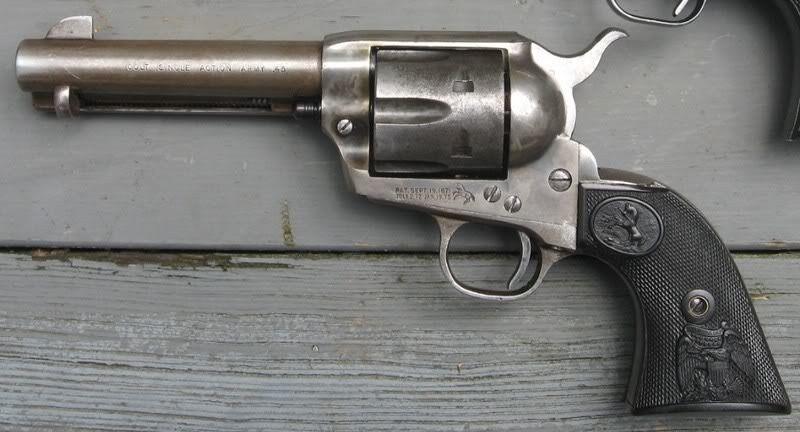Howdy
M'BOGO is correct. The three standard barrel lengths for the Colt Single Action Army were 7 1/2", 5 1/2", and 4 3/4". The original barrel length of the Colt Single Action Army when it was first produced in 1873 was 7 1/2".
Now I do not have this on any specific authority, but I have always thought that the SAA was first introduced with a long barrel because most of the percussion revolvers that preceded it also had long barrels. With a percussion revolver you needed a fairly long handle on the lever under the barrel in order to gain enough mechanical advantage to squeeze a round ball into the chamber. Don't forget, with a percussion revolver you are actually shaving off lead to get a good seal when you seat the ball. Nobody was using modern mechanical stages to load C&B pistols in those days, even if you had multiple cylinders you had to load them right on the gun, and you needed to use the ram and lever built into the pistol to do so. In order to do that you needed a fairly long handle to get enough leverage. And if you need a long lever, you need a long barrel to hang it under, so you can latch the lever at its front end. If I recall correctly, the Colt Walker came with a 9" barrel, the Dragoons and the 1860 Army had 8" barrels, and the 1851 Navy had a 7 1/4" barrel. The 1858 Remington New Model Army also had a 8" barrel. There were some shorter models made, but many of them did not have a loading lever attached. The Paterson Colt did not have one either, you had to hammer the balls into the chambers, not a great idea with Black Powder.
Here is a photo of a typical 1860 Army Colt with its 8" barrel. Notice how the long loading lever is latched all the way at the front. The Walker Colt did not latch at the front, and the lever used to drop down from recoil, disabling the gun until it was relatched in postition. Colt corrected that problem with the Dragoons and all the later C&B models, latching the levers at the front.

So, my assumption has always been that the SAA was first introduced with a long barrel simply because that is just what the shooting public was used to. Why 7 1/2" and not 8"? Who knows. But that is the length that was chosen. Don't forget, when originally introduced the SAA was a military weapon. It was not meant to be concealed, so a long barrel was not an issue. It was first issued to the Cavalry and they usually wore them butt forward on their right side. Not as inconvenient as you might assume, the sabre was the mounted soldier's primary weapon, not his pistol. His sabre was on his left, and he drew it with his right hand. If he needed his pistol he would draw it cross draw style with his left hand.
By the 1890s most of the original 7 1/2" Colts were badly worn. The Army sent most of them back either to Colt or to the Frankford Arsenal, for refurbishing. Most of them had their barrels cut down to 5 1/2" and the front sight was reinstalled. Why 5 1/2"? Again, who knows. Perhaps there was enough muzzle wear that it was felt that 2" should be cut off. But that's what was done, and most of these Colts were then reissued to Artillery units. So the 5 1/2" length became unofficially known as the Artillery Model. That is not an official designation, but it is a fairly common term. About this time Colt started offering the SAA in the 5 1/2" length, and it eventually became the most popular length, more 5 1/2" Colts were sold than any other barrel length. Incidentally, when those Artillery models were reassembled, not much care was taken to make sure that each gun was reassembled with its original parts. Most of them are a mish mash of parts from different guns.
As far as the 4 3/4" barrel length is concerned, it is indeed the shortest barrel one can install and still use the standard ejector rod housing. Here is a photo of my 4 3/4" Colt. If I had flipped it over you would see that the barrel only extends about 1/8" beyond the end of the ejector rod housing, just enough for a decent crown.
My thought is that Mr Ruger wanted to pay homage to the Colt when he first started making Blackhawks, since they are visually very similar to a Colt, and so he chose the standard Colt barrel lengths, except for 4 5/8" inches instead of 4 3/4". Perhaps his ejector rod housing was 1/8" shorter than a Colt.


